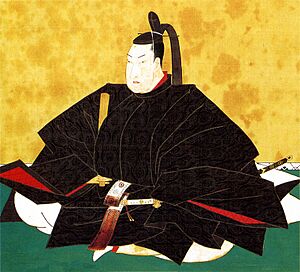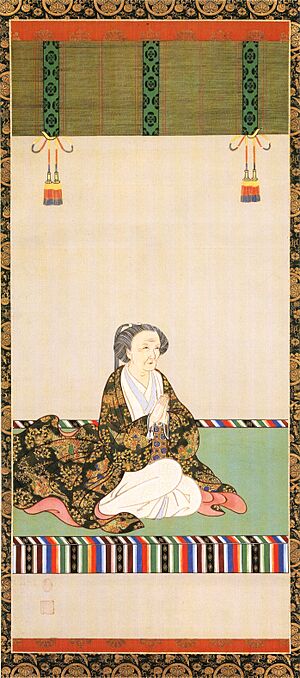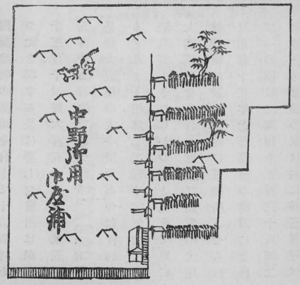Tokugawa Tsunayoshi facts for kids
Quick facts for kids
Senior First Rank
Tokugawa Tsunayoshi
|
|
|---|---|
|
徳川 綱吉
|
|

Tokugawa Tsunayoshi
|
|
| Shōgun | |
| In office 12 August 1680 – 19 February 1709 |
|
| Monarch | |
| Preceded by | Tokugawa Ietsuna |
| Succeeded by | Tokugawa Ienobu |
| Personal details | |
| Born | 23 February 1646 Edo, Tokugawa shogunate (now Tokyo, Japan) |
| Died | 19 February 1709 (aged 62) Edo, Tokugawa shogunate |
| Spouse | Takatsukasa Nobuko |
| Children |
|
| Parents | Tokugawa Iemitsu Keishouin |
| Signature |  |
| Nickname | The Dog Shogun |
Tokugawa Tsunayoshi (23 February 1646 – 19 February 1709) was the fifth shōgun of the Tokugawa dynasty in Japan. He was the younger brother of Tokugawa Ietsuna and the son of Tokugawa Iemitsu. His family was very important in Japanese history.
Tsunayoshi is famous for creating laws to protect animals, especially dogs. Because of these laws, people often called him "the Dog Shogun" (Inu-Kubō).
Contents
Tokugawa Tsunayoshi: Japan's "Dog Shogun"
Early Life and Education
Tokugawa Tsunayoshi was born on February 23, 1646, in Edo (which is now Tokyo). His father was Tokugawa Iemitsu, the third shōgun. His mother was Otama, later known as Keishōin. Tsunayoshi had an older brother, Tokugawa Ietsuna, who was five years older.
From a young age, Tsunayoshi was very bright and lively. His father, Iemitsu, worried that Tsunayoshi might try to take his older brother's place. So, Iemitsu decided that Tsunayoshi should not be trained as a warrior. Instead, he was educated as a scholar. This meant he spent his childhood studying and learning. His childhood name was Tokumatsu.
Tsunayoshi's mother, Keishōin, was a very important person in his life. She was originally from a merchant family in Kyoto but was adopted into a noble family. She gave Tsunayoshi a lot of advice throughout his life.
Becoming the Shogun
In 1651, when Tsunayoshi was just five years old, his father, shōgun Iemitsu, passed away. His older brother, Tokugawa Ietsuna, then became the fourth shōgun. Tsunayoshi lived a quieter life during his brother's rule.
In 1680, shōgun Ietsuna died at the age of 38. This led to a discussion about who should be the next shōgun. Some advisors suggested someone outside the Tokugawa family. However, Hotta Masatoshi, a very smart advisor, strongly supported Tsunayoshi. He believed Tsunayoshi, as the former shōguns brother and the third shōguns son, was the right choice.
Finally, in 1681, Tsunayoshi was officially confirmed as the fifth shōgun of the Tokugawa shogunate.
Ruling Japan: Laws and Learning
After becoming shōgun, Tsunayoshi quickly showed he was a strict ruler. He appointed Hotta Masatoshi as a top advisor, thanking him for his support. Tsunayoshi made it clear that he expected high standards from his officials. He even ordered one lord to take his own life for poor leadership.
In 1682, Tsunayoshi introduced new laws to improve public behavior and living standards. He banned expensive fabrics and tried to control certain types of entertainment. These strict rules sometimes led to people finding ways around them, like smuggling.
Tsunayoshi was also very religious and loved learning. He promoted a philosophy called Neo-Confucianism, which taught about good morals and proper behavior. He often gave lectures to important lords and even to envoys from the Emperor's court in Kyoto. He enjoyed studying Chinese books and was also a fan of Japanese art and Noh theater.
In 1691, a German doctor named Engelbert Kaempfer visited Edo as part of a Dutch embassy. He wrote about his experiences in Japan. Kaempfer noted that Tsunayoshi was curious about Western culture. During their audience, Tsunayoshi reportedly asked the Dutch visitors to talk and sing to see how Westerners behaved.
The Edicts on Compassion for Living Things
One of Tsunayoshi's most famous actions was creating the "Edicts on Compassion for Living Things." These were laws meant to protect animals. Tsunayoshi was born in the Year of the Dog, and he believed he should take special care of dogs.
At the time, there were many stray and sick dogs in Edo. The edicts ordered people to protect dogs and other animals. This led to him being called "the Dog Shogun."
By 1695, there were so many dogs that Edo became very smelly. The situation became extreme, and over 50,000 dogs were moved to large kennels built in the city's suburbs. These dogs were fed rice and fish, paid for by the citizens' taxes.
The Forty-Seven Rōnin Legend
During Tsunayoshi's rule, a famous event known as the Akō incident took place in 1701. Asano Naganori, a powerful lord, had a serious conflict with Kira Yoshinaka in Edo Castle. Asano was punished, but Kira was not.
Later, Asano's loyal samurai, known as the Forty-seven rōnin, sought justice for their lord by taking action against Kira. Their story became a famous legend about loyalty and honor in Japan. It inspired many plays and stories, including the well-known Chūshingura.
Later Years and Legacy
Tsunayoshi faced personal sadness when his first son, Tokugawa Tokumatsu, died young. Later, in 1704, his only surviving child, Tsuruhime, also passed away. Because he had no direct heir, Tsunayoshi appointed his nephew, Tokugawa Ienobu, as the next shōgun. Ienobu was the son of Tsunayoshi's other brother, Tokugawa Tsunashige.
Towards the end of his rule, Japan experienced natural disasters. In 1706, a typhoon hit Edo, and in 1707, Mount Fuji erupted.
Tsunayoshi died on February 19, 1709, just before his 63rd birthday. Some old stories suggested he was attacked, but historical records show he died from measles. He was buried at Kan'ei-ji temple. His rule, especially the "Genroku era," is remembered as a time of cultural growth and unique laws.
Eras of His Rule
The time when Tsunayoshi was shōgun is divided into several Japanese era names, or nengō:
Family Tree
| Ancestors of Tokugawa Tsunayoshi | |||||||||||||||||||||||||||||||||||||||||||||||||||||||||||||||||||||||||||||||||||||||||||||||||||||||||||||||||||||||||||||||||||||||||||||||||||||||||||||||||||||||||||||||||||||||||||||||||||||||||||||||||||||||||||||||||||||||||||||||||||||||||||||||||||||||||
|---|---|---|---|---|---|---|---|---|---|---|---|---|---|---|---|---|---|---|---|---|---|---|---|---|---|---|---|---|---|---|---|---|---|---|---|---|---|---|---|---|---|---|---|---|---|---|---|---|---|---|---|---|---|---|---|---|---|---|---|---|---|---|---|---|---|---|---|---|---|---|---|---|---|---|---|---|---|---|---|---|---|---|---|---|---|---|---|---|---|---|---|---|---|---|---|---|---|---|---|---|---|---|---|---|---|---|---|---|---|---|---|---|---|---|---|---|---|---|---|---|---|---|---|---|---|---|---|---|---|---|---|---|---|---|---|---|---|---|---|---|---|---|---|---|---|---|---|---|---|---|---|---|---|---|---|---|---|---|---|---|---|---|---|---|---|---|---|---|---|---|---|---|---|---|---|---|---|---|---|---|---|---|---|---|---|---|---|---|---|---|---|---|---|---|---|---|---|---|---|---|---|---|---|---|---|---|---|---|---|---|---|---|---|---|---|---|---|---|---|---|---|---|---|---|---|---|---|---|---|---|---|---|---|---|---|---|---|---|---|---|---|---|---|---|---|---|---|---|---|---|---|---|---|---|---|---|---|---|---|---|---|---|---|---|---|
|
|||||||||||||||||||||||||||||||||||||||||||||||||||||||||||||||||||||||||||||||||||||||||||||||||||||||||||||||||||||||||||||||||||||||||||||||||||||||||||||||||||||||||||||||||||||||||||||||||||||||||||||||||||||||||||||||||||||||||||||||||||||||||||||||||||||||||



